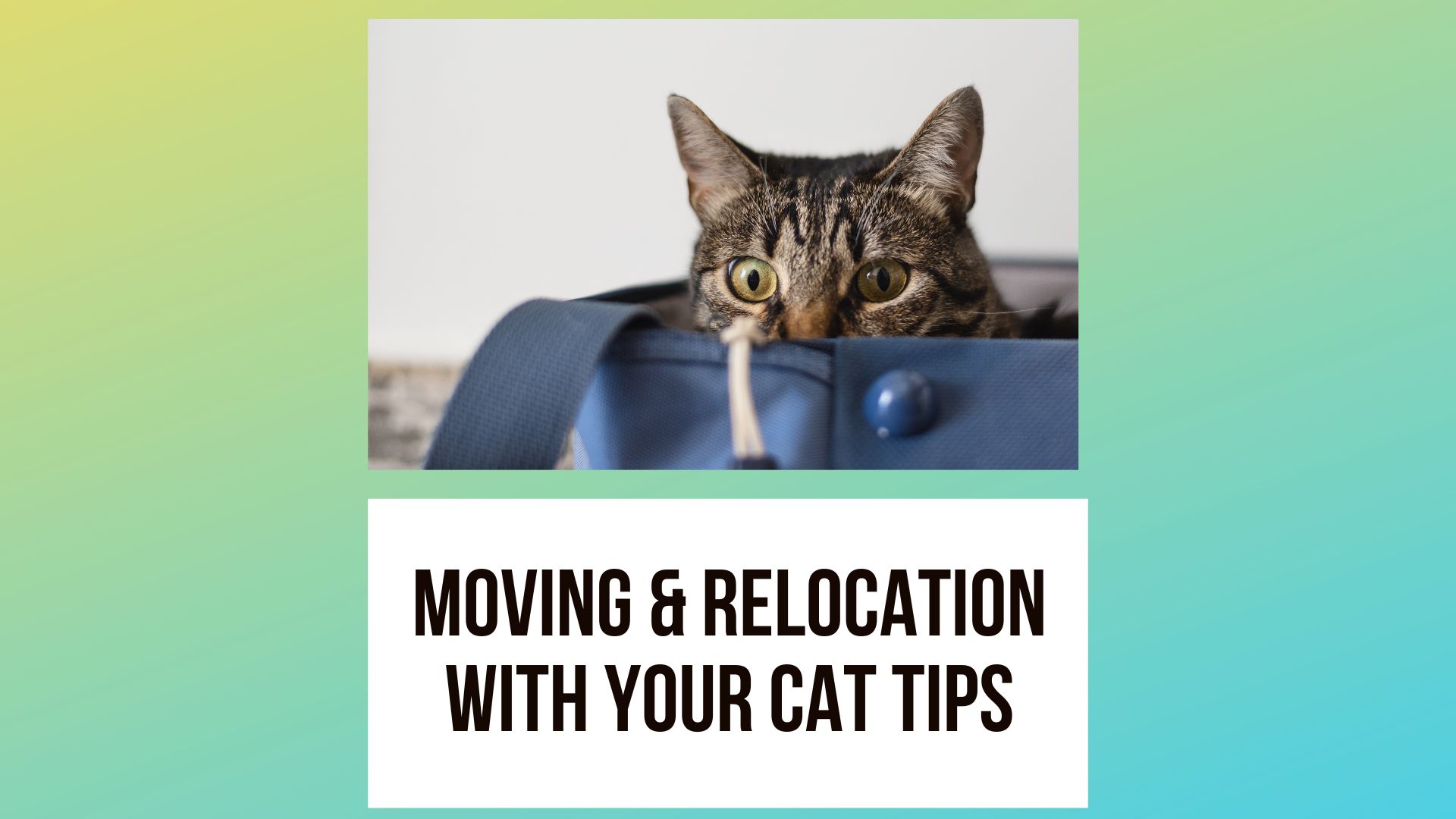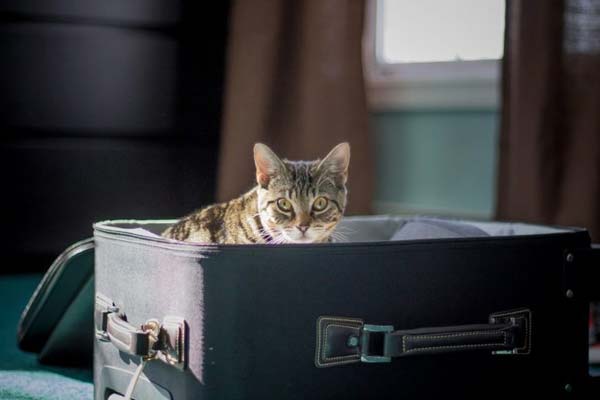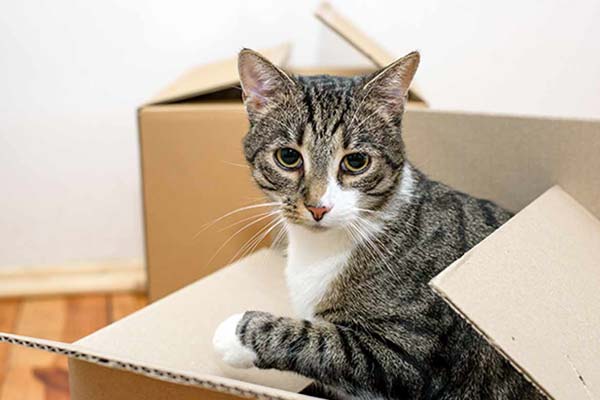
Moving is stressful enough. Add in your cat, and you might find yourself with a finicky feline that looks like your pet but doesn’t act like it due to stress and confusion.
While we can’t guarantee a stress-free relocation for you or your kitty, we can provide you with curated expert advice, tips, and recommendations on how to survive the moving process.
Consistency and Safety are the Keys to a Happy Kitty
This YouTube video highlights many easy ways you can help your cat feel secure and relaxed in the weeks leading up to your move.
When you bring in boxes, let your kitty investigate and sniff them. They might jump in them, sleep in them, or knock them over, so be sure to keep a box or two empty.
You should consider a safe area in your home too. A room with a closing door is ideal as it keeps your cat safe while you or movers remove boxes and furniture from the home.
It can also reduce anxiety, but each cat will react differently, so look to your feline for cues.
If your cat is unused to a carrier, you can set it up with the door open or off in their safe area too. This allows them to become acquainted with it.
During this process try to keep your kitty’s routine as normal as possible. Any small or large deviation can stress out your cat. However, increasing play or petting time can’t hurt.
Take Your Cat to the Vet About a Month in Advance
You’ll need:
- Copies of records if switching vets after the move
- To make sure all shots are up to date
- Any certificates or tags required for travel or hotel stays
- To ensure kitty is in general good health and/or receive prescriptions
Airlines can have stringent rules on the documents you need. Some might require additional shots or tests if traveling outside the country.
Be sure to check beforehand to avoid unnecessary trips back and forth to the vet’s office.
Should You Use Anti-anxiety Medication or Natural Treatment?
While anti-anxiety medications should be a last resort, you can discuss any concerns with your vet and ask for recommendations too.
They might offer you a script or sample to use during your move. According to Hills Pet, you should never give your cat more medication than your vet prescribes.
Pheromone Stress Relief
Pheromone stress relief comes in an array of applications too. You can find treats, sprays, diffusers, and wipes. Some brands come in a collar form too.
Related: The Top Five Shock Collars For Cats, And What You Need To Know About Them
Are they effective? These formulas are iffy with their results. However, if you do use them, PetMD has further information on the types of products and using them.
What about Herbal Remedies?
- Catnip
- Valerian
- Hops
- Chamomile
The herbs or a professionally procured tincture can do wonders for calming down your kitty or stopping stress before it begins. With the exception of catnip, the best way to give your feline a dose is to stuff dried herbs in a toy.
You can also find them pre-dosed in treat form. Just be sure to give your cat a treatment at least 15 minutes before you leave or begin moving. The same goes for using loose dry herbs.
Repeat as needed to keep your cat relaxed, but don’t let them ingest the herbs.
Again, you should consult your vet before using medicinal or topical products as they can cause reactions or interact with some medications. Many essential oils are poisonous to cats.

You may also like: Feliway Travel Spray On The Go Management Behavior Modifier Spray
Related: Six Ways to Naturally Sedate Your Cat
Can You Use Essential Oils to Keep Kitty Calm?
Generally, no, you should not.
Unless you’re working with a holistic animal doctor or a vet well versed in essential oils, you should refrain from diffusing them around your cat. Never apply an essential oil topically to your cat without the guidance of a professional.
Cats lack certain enzymes to break down the volatile compounds in some essential oils. It leads to adverse side effects, internal damage, and it can cause death.
There is a good reason essential oils made the Pet Poison Control’s leading cause of tremors in felines.
Prepare Your New Home for Your Cat’s Arrival
Until you’ve completed the following checklist, your cat should remain in a crate. Setting up another safe cat room is ideal. This will give kitty a full area to explore and access to a bathroom.
The video shows an owner letting their cats out of their crates. If you follow them off YouTube, you’ll see they documented their move with their cats.
Here, they arranged many of their cat furniture and belongings in the new home before they introduced the kitties.
Before opening your kitty’s crate, you should:
- If the home previously had pets, use an enzyme cleaner formulated for cats on carpets and hard surfaces to reduce marking behavior
- Set up litter boxes
- Place down food and water in a location of your choice
- Layout toys and cat furniture in every room
- Set up a second safe place for when outside doors are in use
- Transfer your kitty’s scent to the new home with a sock or clean rag you’ve petted them with
- Cat proof the new house
- Provide kitty with new tags that include updated address and telephone number. Be sure to update microchip information if applicable.
Set Up Litter Boxes
Remember, if your new home is a multi-level house, you should place a litter box on each floor. Another trick is a simple formula. For every cat in your house, you need one box plus one more.
After your cat begins exploring, be sure to show them where each box is. If possible, take some used litter and sprinkle it in each box. This step might sound gross, but it can prevent accidents and assist your cat in scenting out their litter boxes.
Related: How To Find The Absolute Healthiest Litter For Your Feline Friend
Place Your Cat’s Scent in the New Home
Transferring your cat’s scent might seem silly, but felines do recognize items by the sense of smell. Don’t be alarmed if your kitty rubs against walls or rolls around excessively on the carpets. They’re simply making the new area smell right.
Cat-Proof Your House
Cat-proofing is an essential must-do. Cover up the old cat or dog flaps. Patch holes in screens or replace them before you let the kitty out of its crate, and fix any door latches that easily open.
Be sure to check basement and attic doors too. Also, double-check plumbing access panels and secure them with a latch system to keep curious felines from gaining access.
Related: Cat-Proofing Your Furniture: Tips for Avoiding Catocalypse
Gradually Introduce Your Kitty to Your New Home
Finally, and a crucial step, gradually give your cat access to your new home. Too much space too soon can quickly overwhelm your cat. This leads to cat anxiety and adverse behaviors, such as aggression or hiding.
Indoor/Outdoor or Outdoor Only Cats Should Remain Inside for a Time
Your cat might disagree with this, and maybe they’re attempting to escape and explore on their first day. However, your cat needs time to learn their home before they go outside.
A month is ideal, but two to three weeks should be enough to stop them from fleeing or trying to return to your old home.
Letting your cat go outside too soon can run risks, including your kitty forgetting where their home is. Ease your cat into their new surroundings with supervised outside time until they’ve become acquainted with your yard.
You might also wish to sprinkle used litter in your yard to help your cat scent their territory. Another option is purchasing an outside cat enclosure, which gives them a taste of the outdoors safely.
Other concerns that you might not be aware of or prepared for include stray or neighborhood dogs and cats. During the first few weeks of your move, you can determine if allowing your cat outside is a safe option.

How to Survive a Long Distance Move with Your Cat in the Car
If you’ve yet to experience the pleasure of a long-distance move with your cat, you’re unlikely to be prepared for the hours of crying ahead of you. Yes, you read that right, and trust us, your kitty isn’t sorry.
The YouTube video above provides great tips for traveling with your cat by car, which is helpful anytime you need to drive them somewhere.
It can also be good advice when traveling by other methods since she explains about the stress-reducing benefits of a cat carrier.
Don’t try to fit a litter pan in a small travel carrier. Most are too large and make a huge mess. Opt for a larger carrier or a wire cage that provides ample room, or you can wait until you’re at your new home or a hotel.
Even if your cat is leash trained, keep them inside the vehicle unless in their crate. You’re introducing them to more anxiety, new scents, and sounds, and you risk them getting loose.
Calm cats that enjoy traveling should still be in a crate, latched and secured with a seatbelt. This is for their safety as well as the driver’s since having a cat strolling around a moving vehicle is distracting.
Never leave a cat in an unattended vehicle. Don’t leave them inside a hot or cold vehicle with the windows up. Extreme temperatures are deadly and rise or fall quickly.
Don’t yell or scream at your cat to be quiet; this will only create more stress and anxiety. Instead, use a soothing voice and offer reassurance.
Finally, try YouTube or your favorite music app for cat-friendly soothing nature sounds, or give your kitty an all-natural calming sedative, such as Nature’s Miracle Just for Cats Calming Spray.

Help! My Cat Loathes the Carrier
No matter how much you try, some cats will never like their carrier. However, here are a few tips that might persuade your stubborn feline.
PetMD recommends placing cat treats inside the carrier. You can leave an enticing trail that ends at the crate too. Spraying the crate with catnip is another trick that can entice kitty to explore inside. Clicker training is another tip some cat owners find helpful too.
When you’re not using it, leave it out and open. If your cat gets used to it, chances are they will eventually investigate it and find it’s a nice, safe hiding spot.
They might put up a fight when you want them to go inside, but they shouldn’t have anxiety or fear over their crate.
A last resort option is to try a different style of carrier. While this can be pricy, you can always donate extras to a shelter if the company doesn’t allow you to return them. Look for different materials and entrances, such as a top load soft carrier.
Related:
Do You Really Need a Pet-friendly Hotel?
Yes. If you’re making a long-distance move with your cat, you’re going to need a place to sleep too. We can’t stress this enough, but you might have to pay a little more.
Some require additional deposits, which they might not refund. Still, it’s worth it because if your cat damages property, you’re liable.
As soon as you have your moving dates, you should begin booking your hotel room. They fill quickly, and many pet-friendly hotels only allow certain rooms for your furry friends.
Expect your cat to hide in the hotel room, and give yourself ample time to retrieve your feline before checkout time. Treats and catnip can be enticing rewards or use the hotel’s bathroom instead of their safe area.
How to Survive a Move with a Plane Trip
Flying might not be the ideal way to move cross-country, but many people use this method with great success. However, when you add in the feline factor, your move can go from a vacation-like flight to a total disaster pronto.
What You’ll Need Before You Can Fly with Your Cat:
- Your cat’s medical records, a health certificate, and proof of vaccinations
- An airline-approved carrier and travel bowls
- A small container of food if it’s a long flight
- Knowledge of your airline’s pet policy
Many styles of crates and carriers meet the airline’s standards. However, always check with individual airlines as seat space can vary. You don’t want to discover on the day of your move that you will have to purchase a new one.
Airlines also have various rules on where your cat will be during the flight. A few airlines will place your feline in the cargo hold, which could increase your kitty’s anxiety, and you should do your best to avoid these airlines when possible.
Others will allow you to place your crate underneath the seat in front of you, and a small handful will allow your feline to fly on your lap in its carrier.
Airlines might charge additional fees for traveling with a pet. Again, you should call the airline or check their website before you buy plane tickets.
Related:
More Flight Tips
- Avoid layovers when possible
- Consider a soft-sided carrier with multiple windows to help your cat feel safe
- Be prepared to carry your cat through the TSA screening process
- Book as early as possible
- Ask the airline for their exact seat measurements
- Double-check the pet policy, e.g. what happens if your cat becomes unruly or has an accident
- Consider talking to your vet about a sedative or alternative therapies, such as a kitty Thundershirt
Our Final Thoughts on Moving with Your Cat Without Losing Your Sanity
Consistent routines are what make cats feel safe. Do your best to continue feeding and playing at your normal times. Don’t be afraid to give your cat extra love or exercise during the moving process.
Let your cat explore boxes and packing tape. Until you’re moving boxes and furniture outside to a truck or pod, your cat can be part of the process. They want to be too, so don’t punish them for their natural curiosity.
Remember, any stress or anxiety will be temporary. It can last beyond a week post move, but if you’re concerned that there might be another cause, take your cat to a vet to rule out underlying issues.
Some cats handle moving to a new house with feline grace. Other cats will fight you at every corner and at each little change from their routine.
Look to your cat for cues, and make adjustments as needed. Forgive yourself if your move and set up your new home is less than perfect. Your kitty will forgive and forget once acclimated to its new surroundings.

Hi, This is Alexa, and I love cats. This Website is a Complete Journal about how to travel with a cat and other information about Cat Health, Cat Training, Cat Behavior, Cat Foods and more. I hope you find it useful.
